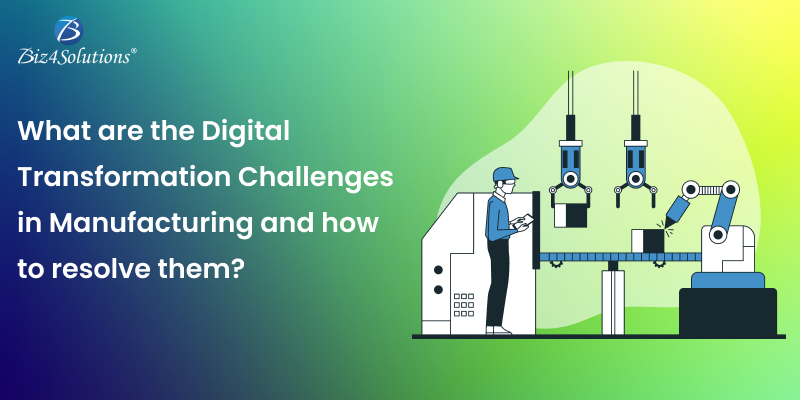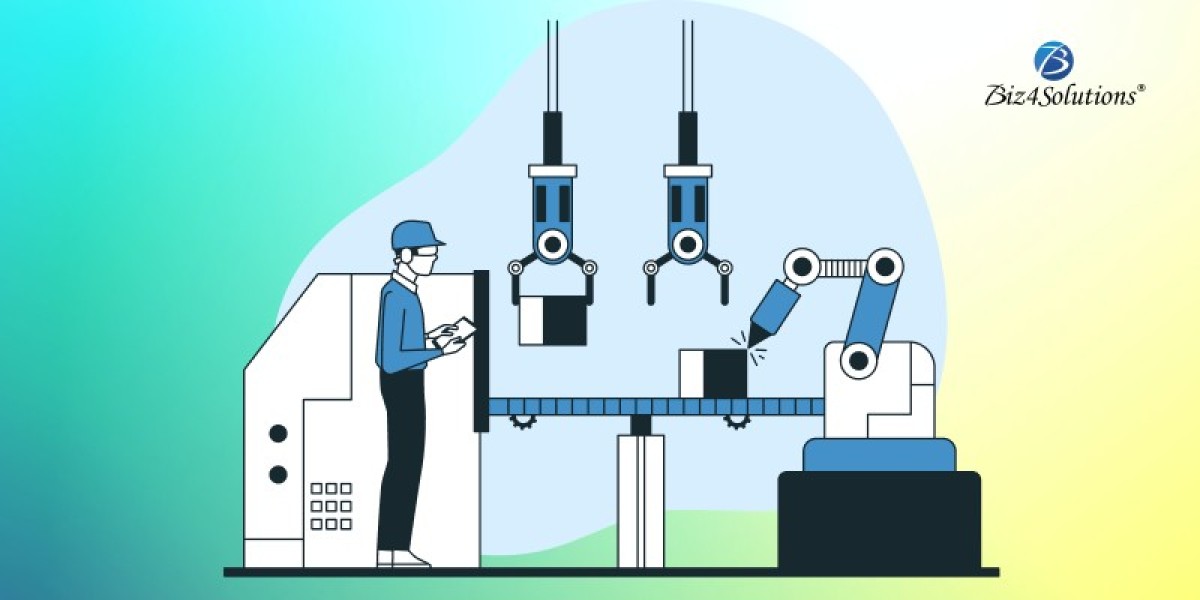
Digital transformation involves leveraging digital technologies to create new or adapt to the existing business processes, organizational cultures, and customer interactions to address evolving operational and market requirements, ultimately gaining a competitive advantage. To stay competitive in the manufacturing industry in a world that is constantly changing, your operations must be automated and digitalized. Some examples are the Industrial Internet of Things (IIoT), advanced data analytics, artificial intelligence, machine learning, and cloud-based computing.
Organizations can modernize their company’s processes and make them future-ready with the help of transformations, but it is easier said than done. There may be some fundamental difficulties with revamping that prevent manufacturers from moving forward with their plans. As a business leader, you must be aware that difficulties with reconstruction are not always directly related to issues with technology or technical obstacles. It may also include problems related to organizational structures, human-oriented issues, and other non-technical aspects. You can overcome these bottlenecks by identifying and assessing the specific problems that affect your business.
This post enlists some of the challenges encountered by the manufacturing sector when modernizing its existing infrastructure. We have also suggested workable solutions to resolve these roadblocks. But, before we proceed, take a look at the reasons why you should consider revolutionizing your manufacturing business.
Why do you need to digitally transform your Manufacturing Businesses?
The need for transformation is a strategic one; it is not just a tech industry buzzword. The implementation of the digital revolution in manufacturing can boost the sustainability of your company while also enhancing worker safety, productivity, and quality. Some of the key advantages of transformation are listed below.
- Higher productivity
- Data-driven customer insights
- Greater satisfaction for customers
- Improved Agility
- Enhanced Company Culture
- Reduced Time-to-Market
- Minimal human error
- Scope for future digital growth
The seven main obstacles to Digital Transformation in Manufacturing and Solutions to them

Capital Investment
When organizations wish to digitally transform their business operations, the initial capital investment expenditure can be a cause of concern. But, entrepreneurs must prioritize the long-term objectives. In the long run, ROI is a vital aspect for every company and you need to consider this factor. Transformation does involve initial investment costs. But, you need to think about the downsides and extra operational costs you will have to incur if you don't invest in technology to keep up with the global movement.
Various strategies to overcome this difficulty
A solid expenditure plan is essential for ensuring that companies know what amount of capital to set aside and when, which modifications to make, and how to evaluate what they have accomplished. For more effective decision-making, have an approximate estimate of the capital expenses involved and the amount of revenue you will generate after digitally transforming your business. Evaluate the return on investment by considering the effects of technological transformation, assessing associated risks, and considering financial resource capabilities.
Companies need to foresee future variables like incremental revenue generation, cost reduction, etc. They must have plans to scale the system as output pay for themselves through higher production by using cloud-based software and affordable hardware. You need to determine how much value each department will add and contribute to the success of the company as a result of transformation. Based on this information, distribute the funds among them. The total capital investment ought to align with the firm's ambitious long-term objectives.
Resistance to Change
Several manufacturing companies have a traditional culture and may be resistant to change. Here’s the reason! Manual laborers comprise a majority of the workforce in the manufacturing sector. And since the involvement of technological solutions can reduce the need for manual labor, transformation may be unwelcome in several business cultures. Also, an employee may feel threatened because going through a digital revolution in manufacturing is the definition of discomfort. This can make it difficult for the business enterprise to implement technological transformation initiatives, as employees may be hesitant to adopt new technologies or processes. But, one must always remember that business cultures that are resistant to change result in delayed progress. Businesses run the risk of losing significant growth opportunities if they don't address these issues.
Solution
Although you might not be able to completely remove employees' doubt and uncertainty, you can certainly lessen it. Manufacturing companies can involve employees in the transformation process from the outset, by communicating its benefits and involving them in decision-making. Being transparent is the key to open and speedy communication and builds a trustworthy environment for everyone.
Companies need to arrange for training and support programs to help employees adapt to new technologies and processes. Besides, employees need to be retrained for their new roles because when machines take over people's jobs, it creates new opportunities for workers in other fields. Moreover, it’s important to make the infrastructure agile and adaptable to any sort of change that will happen in the future as technology evolves.
Lack of Digital Expertise
To undergo digital revamping, a combination of talent and technology is required. A basic understanding of technology will be necessary for even a non-technical position. But, manufacturing companies are least likely to have sound technical expertise. And, finding and training people to successfully deploy digital solutions becomes a challenge for many manufacturing firms. Unfortunately, it can be difficult and even expensive to find the ideal candidates as the pool of potential employees is quite small in this domain. Nevertheless, there are some ways you can use to address this situation.
Solution
Revamping will bring with it a lot of technical challenges and complex tasks like data analytics and data visualization. You may also need to develop a mobile app to serve this purpose. So, you will need the right people on board, or you will need to train your workforce to be digitally literate and help them develop the skills needed for innovation. If you plan to implement advanced data analytics, AI, machine learning, digital twins, and automation, you must ensure that the best practices and the most productive strategies are followed. Also, every company may have a different set of requirements and you need to choose the software solution as per the requirement.
However, manufacturing companies might not have their own tech teams to answer all of these questions or suggest the best operational plans. Here, outsourcing can help you to lessen the stress of adoption. You can seek the advice of professional consultants in digital transformation services or assistance from mobile app development services. Such services will evaluate your current manufacturing process and assist you to pick the technology that best suits your organizational need and business objectives. With experts' assistance, you will be able to meet your long-term objectives expected out of transformation.
Rigid or Legacy Infrastructure
Some of the basic requirements of technological transformation include cloud infrastructure, new-age computers, and fast internet. However, several manufacturing companies still depend on legacy systems that are not designed for digital operations. Besides, certain legacy systems can be difficult to upgrade due to incompatibility with new digital technologies. In such cases, you need to remodel your entire organizational structure which is a costly affair. And, managing organizational-wide change can be one of the most noticeable issues with the transformation, even if you create a strong strategy for it.
Ways to overcome this challenge
To begin with, a manufacturing company should perform an overall evaluation to determine whether it's time to retire specific legacy systems. It’s advisable to replace legacy systems with modern, cloud-based platforms gradually, instead of remodeling the entire infrastructure in one go.
Estimate the value that can be added by replacing each of your systems with new technology. Identify the departments that can reap optimum benefits from the technological transformation initiative. Prioritizing the areas or departments that you need to transform at first will help you make the right decision. The remaining departments can be digitalized over time.
Lack of a Strategy to implement Transformation
Without a predetermined strategy, a transformation project cannot be successful. Therefore, having a plan in place is essential. The transformation plan includes not only infrastructure but also, among other things, mindset, processes, analytics, quick decision-making, and agility.
Ways to overcome this challenge
You should consider your company's priorities and goals before planning. To make a plan that is suitable for your project, you have to ask some questions before making a strategy.
- Is the plan uniform throughout the company, or are there some areas on entirely different pages?
- Why do you prefer new digital systems over outdated ones and manual processes?
- Does your company intend to implement sophisticated systems?
- Are you prepared to transition your current systems into new ones in a proper manner?
You'll have a better understanding of where your business can grow and what areas require upgrades once you know the answers to these questions.
Constant change in Customer Demands
Customer demands are constantly changing. Although customers initially appreciate better services, they soon grow accustomed to it and their demands and expectations grow with time. The process of transformation is difficult, and sustained transformation efforts can take years to complete. This transformation will require a significant time and financial commitment from you. The success of this transformation would have a lot at stake. And, when the time comes to implement new digital technologies, don't be surprised if the customer requirements change suddenly and prepare to be flexible.
Ways to overcome this challenge
- Utilize data analytics and constantly update customer information.
- Keep an eye on customer needs and solicit their opinions.
- Streamline your corporate procedures.
- Achieve supply chain optimization.
- Create a flexible process and an agile team.
- Constantly evaluate your sales and marketing strategies.
Concerns Regarding Safety
Manufacturing companies handle large amounts of sensitive data, including customer information, intellectual property, and trade secrets. Protecting this data from cyber threats and breaches is a major concern for many enterprises. Moreover, some businesses hurriedly adopt digital transformation solutions to respond to the sudden shifts in consumer demands. This makes them vulnerable to cyber security risks. The reason is a majority of these systems are internet-based and cloud-based. Additionally, they might have Ethernet for connecting traditional analog equipment to the floor. Naturally, this raises the threat of cyber-attacks that can expose client information and business secrets. So, make sure you have a robust strategy in place to prevent these threats. There are some steps you must take to ensure safety.
Ways to overcome this challenge
Adopt a security-first mindset. As the first line of defense, security must be integrated into all applications. Recognize the important information assets that need to be secured primarily. Determine the dangers that may arise if the data is lost or compromised. Establish secure procedures, assign management roles, and implement necessary safety measures based on this information.
Manufacturing companies can implement robust cybersecurity measures, such as firewalls, intrusion detection systems, and encryption protocols, to protect their data from cyber threats. They can also comply with relevant data privacy regulations, such as GDPR, by implementing data protection policies and procedures.
What’s next?
It takes more than just implementing digital technologies to achieve successful technological transformation in the manufacturing industry. Additionally, it requires adding more value. Adopting the most innovative technology by itself does not ensure success. You will face a number of internal and external difficulties that could prevent the transformation.
Manufacturers need to determine the key value establishment areas that can be developed. With this information as the foundation for your plan, you can instill changes in your organizational structure and culture while keeping ROI a priority. By contacting external consultants with experience in providing direction and resources, manufacturers can take the first step toward integrating advanced manufacturing technology.
 " class="wow_main_float_head_img">
" class="wow_main_float_head_img">







